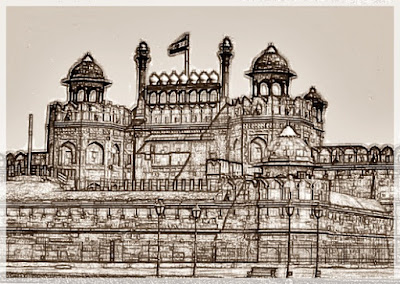1. Red Fort: A fort built by the Mughal emperor Shah Jahan in the walled city of Old Delhi (present day Delhi, India) in the walled city of the Red Fort in the seventeenth century. Until 1857, this fort was the capital of the Mughal empire. Then, when the British Indian government exiled Bahadur Shah of the Mughal Emperor II, the Indian capital was transferred to Calcutta. By 1947 the British used this fort as a military camp. Currently, it is a popular tourist center and a strong symbol of the sovereignty of the Indian Republic: On the occasion of Indian Independence Day, Indian Prime Minister hoists the national flag at a place adjacent to the Lahore Gate of Red Fort. In 2007, this facility was chosen as a UNESCO World Heritage Site.
 |
| Red Fort |
In 1638, Emperor Shahjahan started the construction of the great fort. The construction ended in 1848. Initially, the name of this fort was "Kila-i-Mubarak" ("Baptist fortress"); Because the family of Emperor lived in this fort. The fort is situated on the banks of the river Jamuna. Due to the drought-like trench in the river's water The fort is connected to another ancient fort named Salimgarh Fort, the northeast corner wall. In 1546, Islam Shah Suri built this defense fort. The planning and decoration of the Red Fort is an important feature of Mughal architecture and painting in the reign of Shah Jahan. In reality, the Red Fort was the capital city of Shahjahanah, the new capital of the seventh city of Shahjahan in Delhi area. Subsequently, however, he shifted the capital from Delhi to Agra. On March 11, 1783, the Sikhs could temporarily enter the Red Fort and capture the Diwan-i-Mama.
The last Mughal emperor living in the Red Fort was the second Bahadur Shah Zafar. After the failure of the Great Revolt of 1857, the second Bahadur Shah Jafar left the Red Fort on 17 September. Later he returned to this castle as a British prisoner. Here he started his trial on January 27, 1858, and on 7 October he was sentenced to exile. Then the Red Fort went under the control of the British Indian Army. They used it as a cantonment. After the defeat of Azad Hind Fauj in 1945, prisoners of war were tried in the Red Fort. Since independence, until 2003, the fort was under the control of the Indian army.
Red Fort decoration and artwork are very high quality. This innovative artwork created by a mix of Persian, European and Indian art forms, colorful and individuality claimants. Delhi's Red Fort is one of the most important structures in India, with the addition of Indian art to historical sources. This castle is also very important in the field of architectural pleasures. For this reason, the red fort was declared as national importance in 1913 and the government took charge of the maintenance of the canal.
The wall of the castle is smooth and firm. Two main gates of the fort - Delhi Gate and Lahore Gate. The Lahore Gate is the main door. This gate covers a long covered market route. Its name is Chatta Chak. The road is arranged by the stall with the stairs of the two-walled street. North and South paths are found in Chatta Chowk. This route is actually the border between the western military field and the eastern palace. The gate on the south side of this path is the Delhi Gate.






कोई टिप्पणी नहीं:
एक टिप्पणी भेजें